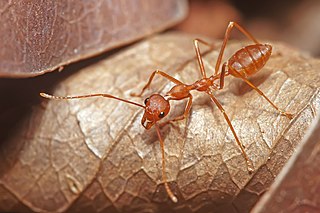
Ants are eusocial insects of the family Formicidae and, along with the related wasps and bees, belong to the order Hymenoptera. Ants evolved from vespoid wasp ancestors in the Cretaceous period. More than 13,800 of an estimated total of 22,000 species have been classified. They are easily identified by their geniculate (elbowed) antennae and the distinctive node-like structure that forms their slender waists.

Apache Ant is a software tool for automating software build processes for Java applications which originated from the Apache Tomcat project in early 2000 as a replacement for the Make build tool of Unix. It is similar to Make, but is implemented using the Java language and requires the Java platform. Unlike Make, which uses the Makefile format, Ant uses XML to describe the code build process and its dependencies.

Formica is a genus of ants of the subfamily Formicinae, including species commonly known as wood ants, mound ants, thatching ants, and field ants. Formica is the type genus of the Formicidae, and of the subfamily Formicinae. The type species of genus Formica is the European red wood ant Formica rufa. Ants of this genus tend to be between 4 and 8 mm long. Ants belonging to the Formica genus possess a single knob or bump located between their thorax and abdomen. These ants primarily feed on honeydew, a sugary liquid produced by aphids. Formica ants appear to take on a shepherding role with smaller aphids, relocating them to different parts of plants to ensure a continuous food source for the aphids. By doing so, the ants can establish a relatively sustainable honeydew supply for both themselves and their colony.

Ponerinae, the ponerine ants, is a subfamily of ants in the Poneromorph subfamilies group, with about 1,600 species in 47 extant genera, including Dinoponera gigantea - one of the world's largest species of ant. Mated workers have replaced the queen as the functional egg-layers in several species of ponerine ants. In such queenless species, the reproductive status of workers can only be determined through ovarian dissections.

Treehoppers and thorn bugs are members of the family Membracidae, a group of insects related to the cicadas and the leafhoppers. About 3,200 species of treehoppers in over 400 genera are known. They are found on all continents except Antarctica; only five species are known from Europe. Individual treehoppers usually live for only a few months.

Nagarahole National Park is a national park located in Kodagu district and Mysore district in Karnataka, India.

Oecophylla smaragdina is a species of arboreal ant found in tropical Asia and Australia. These ants form colonies with multiple nests in trees, each nest being made of leaves stitched together using the silk produced by the ant larvae: hence the name 'oecophylla' [Greek for 'leaf-house'].
Barry Bolton is an English myrmecologist, an expert on the classification, systematics, and taxonomy of ants, who long worked at the Natural History Museum, London. He is known especially for monographs on African and Asian ants, and for encyclopaedic global works, including the Identification Guide to Ant Genera (1994), A New General Catalogue of Ants of the World, Synopsis and Classification of Formicidae (2003), and Bolton's Catalogue of Ants of the World: 1758-2005 (2007). Now retired, Bolton is a Fellow of the Royal Entomological Society and Myrmecologist, Biodiversity Division, Department of Entomology, Natural History Museum, London.

Jharkhandi cuisine is the cuisine of the Indian state of Jharkhand. Staple foods are rice,roti dal and vegetables. Common meals often consist of vegetables that are cooked in various ways, such as curried, fried, roasted and boiled. Many traditional dishes of Jharkhand may not be available at restaurants.

Puttingal Temple is a Hindu temple in the coastal town of Paravur, India. The temple was founded after the presence of the goddess was experienced on an ant hill with Puttu being the Malayalam word for ant Hill.

Phrynoponera is a strictly Afrotropical genus of ants in the subfamily Ponerinae.

Bothroponera is a genus of ants in the subfamily Ponerinae. It is distributed in Africa and Asia.
Athipattu Pudunagar [Acronym: ANT] is a census town in Thiruvallur district in the state of Tamil Nadu, India. It is to the north of Chennai city. The town is served by Athipattu Pudhunagar railway station of the Chennai Suburban Railway network. Special Industrial area of Tamil Nadu. Surrounded by Kamarajar Port, North Chennai Thermal Power Station, NTECL, India Cement, Zuari Cement, L&T Shipbuild, IOCL, HPCL, BPCL & more Container yard terminals.

Ant eggs refer to both the eggs and pupae of weaver ants eaten in several countries across Southeast Asia, especially Laos and Northeastern Thailand (Isan). They are high in protein and enjoyed for their sourness and pop when eaten along with soups, omelets, and salads.

Ponerini is a tribe of Ponerinae ants with 46 genera and 6 extinct genera.
Pheidole latinoda is a species of ant in the subfamily Myrmicinae. It is found in India and Sri Lanka.

Diacamma rugosum, also known as the Bornean queenless ant or Asian bullet ant, is a species of ant of the subfamily Ponerinae. It is found in many countries throughout Southeast Asia. 20 subspecies are recognized.

Ant Group, formerly known as Ant Financial, is an affiliate company of the Chinese conglomerate Alibaba Group. The group owns the world's largest mobile (digital) payment platform Alipay, which serves over 1.3 billion users and 80 million merchants, with total payment volume (TPV) reaching CN¥118 trillion in June 2020. It is the second largest financial services corporation in the world, behind Visa. In March 2019, The Wall Street Journal reported that Ant's flagship Tianhong Yu'e Bao money-market fund was the largest in the world, with over 588 million users, or more than a third of China's population, contributing cash to it.
Ant, also spelled Aunt, is a village in Mal block of Lucknow district, Uttar Pradesh, India. As of 2011, its population was 1,138, in 227 households. It is the seat of a gram panchayat.













